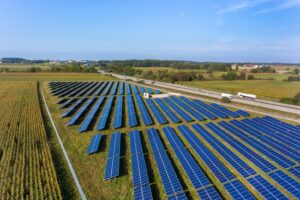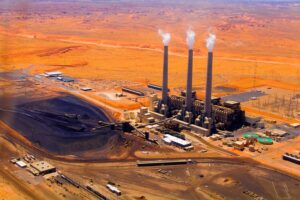The UK’s greenhouse gas emissions fell by 3.6% in 2024 as coal use dropped to the lowest level since 1666, the year of the Great Fire of London, according to new Carbon Brief analysis.
Major contributions came from the closure of the UK’s last coal-fired power station in Nottinghamshire and one of its last blast furnaces at the Port Talbot steelworks in Wales.
Other factors include a nearly 40% rise in the number of electric vehicles (EVs) on the road, above-average temperatures and the UK’s electricity being the “cleanest ever” in 2024.
Carbon Brief’s analysis, based on preliminary government energy data, shows emissions fell to just 371m tonnes of carbon dioxide equivalent (MtCO2e) in 2024, the lowest level since 1872.
Other key findings from the analysis include:
- The UK’s emissions are now 54% below 1990 levels, while GDP has grown by 84%.
- About half of the drop in emissions in 2024 was due to a 54% reduction in UK coal demand, which fell to just 2m tonnes – the lowest level since 1666.
- Another third of the drop in 2024 emissions was due to falling demand for oil and gas, with the remainder down to ongoing reductions in non-CO2 greenhouse gases.
- UK coal demand fell at power stations (one-third of the reduction overall) and at industrial sites (two-thirds). In 2024, the UK closed its last coal-fired power station, as well as the final blast furnace at the Port Talbot steelworks. Furnaces at Scunthorpe paused operations. Both sites are due to convert to electric-arc furnaces that do not rely on coal.
- Oil demand fell 1.4% despite increased road traffic, largely due to the rise in the number of EVs. The UK’s 1.4m EVs, 0.8m plug-in hybrids and 76,000 electric vans cut oil-related emissions by at least 5.9MtCO2e, Carbon Brief analysis finds, only slightly offset by around 0.5MtCO2e from higher electricity demand.
- The UK’s EV motorists each saved around £800, on average, in 2024 – some £1.7bn in total – relative to the cost of driving petrol or diesel vehicles.
- Gas demand for heating increased, despite warmer average temperatures than in 2023, as prices eased from the peaks seen after the global energy crisis.
- However, gas demand fell overall due to lower gas-fired electricity generation, thanks to higher electricity imports and increased output from low-carbon sources.
The UK would need to cut its emissions by a larger amount each year than it did in 2024, to reach its international climate goal for 2035, as well as its national target to reach net-zero by 2050.
The analysis is the latest in a decade-long series of annual estimates from Carbon Brief, covering emissions during 2023, 2022, 2020, 2019, 2018, 2017, 2016, 2015 and 2014.
Lowest since 1872
The UK’s territorial greenhouse gas emissions – those that occur within the country’s borders – have now fallen in 26 of the 35 years since 1990.
(Consumption-based emissions, including CO2 embedded in imported goods and services, were increasing until 2007, but have since fallen at a similar rate to territorial emissions.)
Apart from brief rebounds after the global financial crisis and the Covid-19 lockdowns, UK emissions have fallen every year for the past two decades.
The latest 14MtCO2e (3.6%) reduction takes UK emissions down to 371MtCO2e, according to Carbon Brief’s new analysis.
This is the lowest since 1872 and on par with 1926, when there was a general strike, as shown in the figure below. In 1872, Queen Victoria was on the throne and Wanderers beat Royal Engineers in the first-ever FA Cup final, held at Kennington Oval in south London.
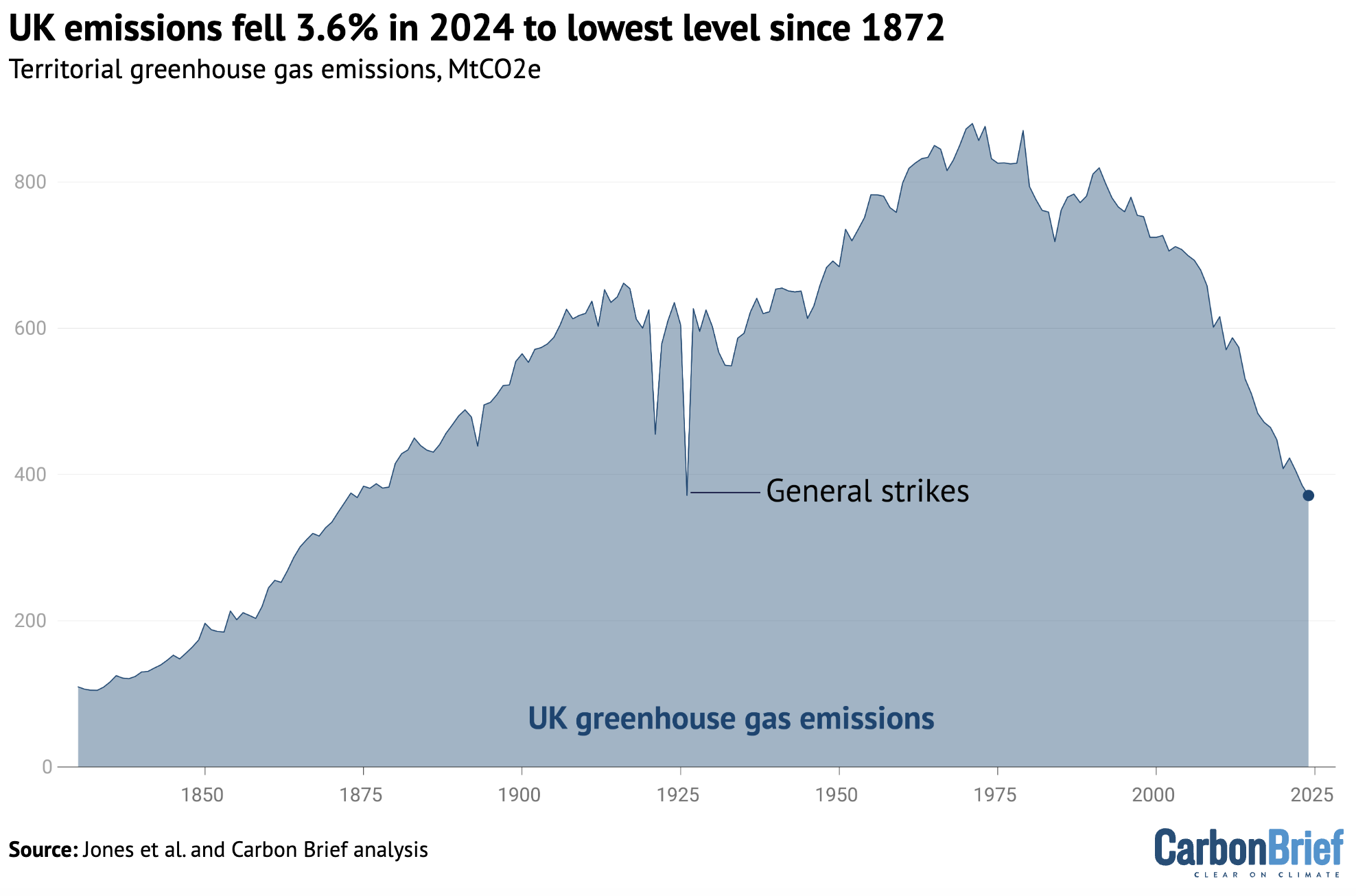
The UK’s emissions are now definitively below the level reached only temporarily during the height of Covid in 2020, having fallen steadily in each of the past three years.
They are now at levels not seen consistently since Victorian times.
Coal collapse
The largest factor in emissions falling last year, accounting for around 7MtCO2e or two-thirds of the reduction overall, was a massive 54% drop in UK coal demand.
In percentage terms, this was the fastest annual reduction in UK coal demand on record, in figures going back to the 16th century. (In absolute terms, the 2.4Mt fall in coal use in 2024 is easily eclipsed by the 34Mt reduction seen during the 1984 miners’ strike.)
The UK used just 2.1Mt of coal in 2024. As shown in the figure below, this is the lowest amount since 1666, when the UK’s capital city was engulfed in the Great Fire of London.
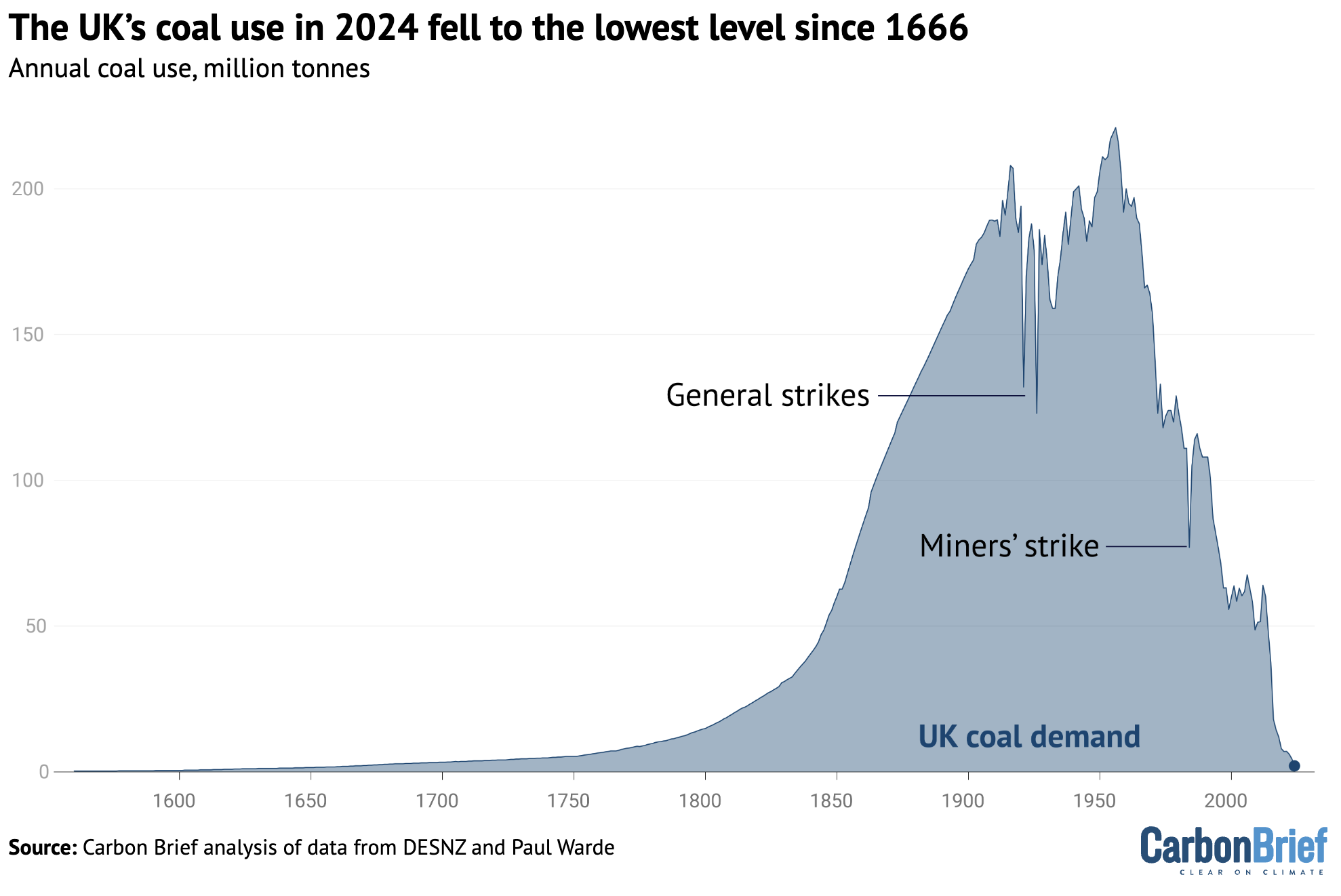
Roughly one-third of the drop in coal use overall last year was due to the closure of the UK’s last coal-fired power station, at Ratcliffe-on-Soar in Nottinghamshire. (For more on how the UK became the first G7 country to phase out coal power, see Carbon Brief’s in-depth interactive feature.)
The plant supplied power to the grid for the last time in September 2024, bringing to an end a 142-year era of using coal to generate electricity in the UK.
The shift away from coal power towards low-carbon sources has been one of the driving forces of UK emissions cuts in recent years.
Indeed, in the period since the UK’s Climate Change Act was passed, the amount of coal used to generate electricity has dropped by 99%, from 48Mt in 2008 to less than 1Mt in 2024. This accounts for the large majority (84%) of the total reduction in coal use over the same period.
Steel slide
In 2024, however, two-thirds of the drop in UK coal consumption – and one-third of the drop in emissions overall – came from lower coal use by heavy industry.
This was largely due to lower steel production, which fell from 5.6Mt in 2023 to 4.0Mt in 2024, a reduction of 29%. This 1.6Mt drop in production was mostly offset by a 1.3Mt increase in imports.
The Port Talbot steelworks in Wales shut down its last two blast furnaces in April and September, with owner Tata blaming losses of £1m a day for the closures.
Since the site last made a profit in 2022, UK and global steel prices have fallen sharply, as shown in the figure below. US credit rating agency Fitch Ratings says the decline in prices, down to weak demand and high exports from China, is “putting pressure on producers’ margins”.
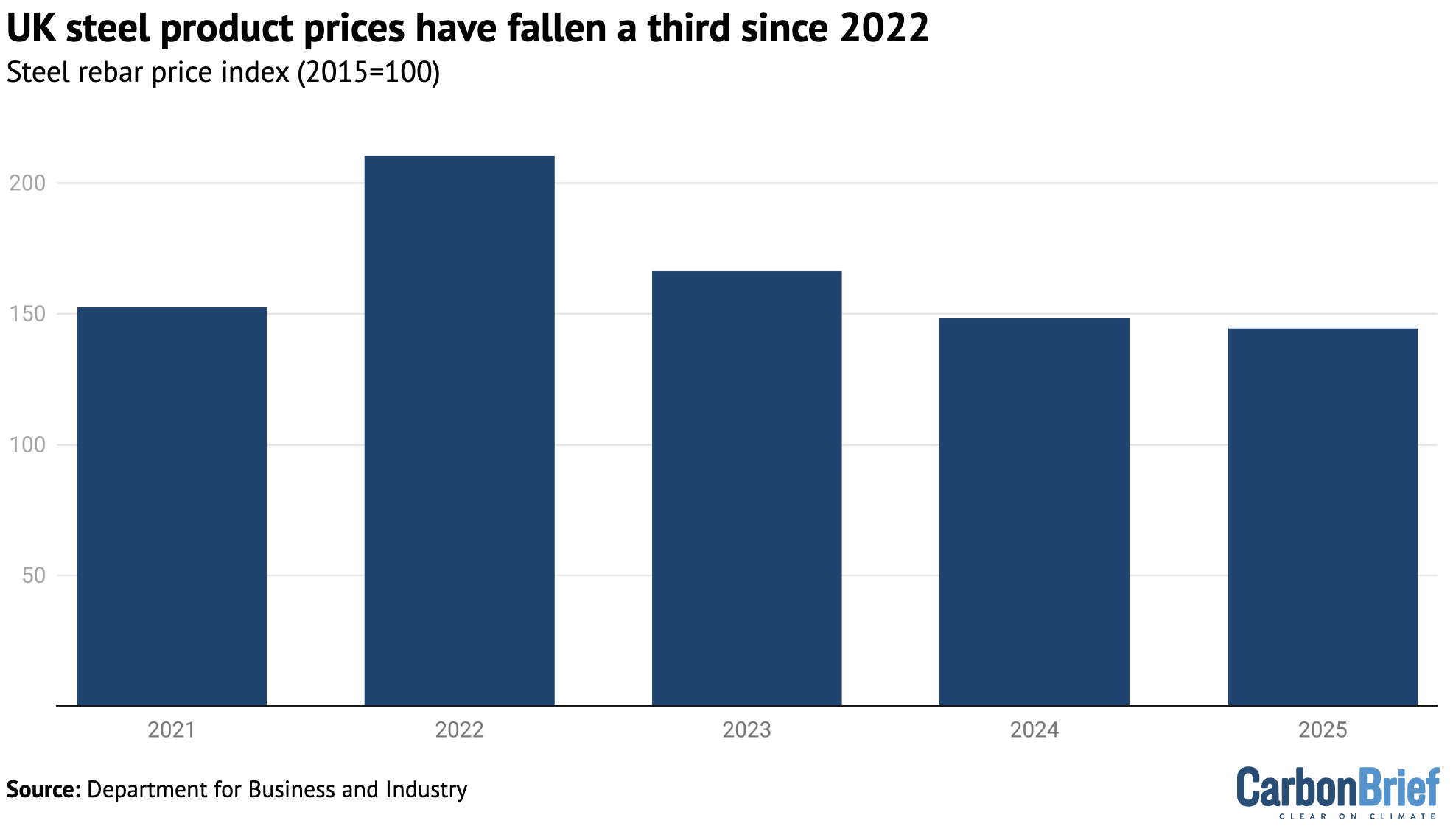
Many commentators have tried to blame climate policy or electricity prices for the steel sector’s problems. However, energy only makes up a tiny fraction of coal-based steel production costs.
Moreover, steelmakers around the world – from China to South Africa – are facing similar challenges, with prices falling as a result of supply being significantly greater than demand.
Industry group Eurofer says the European market is being “flooded by cheap foreign steel”. It adds that economic headwinds in China, including its real-estate slowdown, have seen “around 100m tonnes of Chinese steel…flooding major markets at dumping prices”.
As such, it is not at all clear that the UK steel sector would have fared differently – or that the Port Talbot blast furnaces would have remained open – in the absence of climate policy.
For example, the sector is part of the UK emissions trading scheme (UKETS), meaning it nominally faces a carbon price that imports from outside the EU would not have to pay.
Yet UK (and EU) steelmakers continue to receive free allowances to shield them from the risk of “leakage” due to competition from abroad. The Port Talbot steelworks received more than 21m free allowances to cover its emissions in the period 2021-2025, worth roughly £1bn. Similarly, the Scunthorpe steelworks received nearly 17m allowances worth around £0.8bn.
From 2027, the UK plans to follow the EU in shifting from free allowances to a carbon border adjustment mechanism (CBAM), under which importers must pay an equivalent carbon price.
The closure of the UK’s blast furnaces is not the end of the story for steelmaking in the country. Indeed, Tata has pledged an investment worth £1.25bn to reopen its Welsh site with electric arc furnaces, which do not rely on coal. This includes up to £0.5bn from the government. Tata says it will have the capacity to produce 3Mt of steel per year from late 2027 or early 2028.
Production also paused in 2024 at the Scunthorpe steelworks, run by the Chinese-owned British Steel, reportedly due to managers ordering the wrong type of coal. Its blast furnaces are now operating again, but it is also looking to shift to electric arc furnaces with government support.
The UK steel industry has welcomed the shift to electric arc furnaces, but has called for efforts to reduce electricity prices, including the 2024 “supercharger” scheme that exempts heavy industry from additional costs relating to renewable subsidies and electricity network charges.
The government’s February 2025 steel strategy looks at issues including “overcapacity in global markets” and the “influence of electricity prices on the competitiveness of the steel sector”.
Rise of EVs
After coal, the next-largest chunk of emissions cuts in 2024 came from lower demand for oil and gas, which accounted for around a third of the reduction overall.
The 1.4% drop in oil demand is particularly interesting, given that traffic on the UK’s roads has been increasing in recent years.
The number of miles driven on UK roads increased by more than 1% in 2024 and is now close to pre-pandemic levels. Yet UK demand for road-transport fuels fell by another 1.6% in 2024 and is now nearly 14% lower than it was in 2019, as shown in the figure below.

Along with improvements in fuel efficiency, the rise of EVs is a key part of this phenomenon.
The UK’s right-leaning newspapers have been busy finding new driving-related wordplay for what they have misleadingly described as a “stalling” market for EVs, which is apparently “going into reverse”.
The reality is that the number of EVs on the UK’s road rose from 1m in 2023 to 1.4m in 2024, an increase of 39% in just one year. The number of plug-in hybrids was up 28% to 0.8m.
Along with 76,000 electric vans, these EVs cut oil-related emissions by at least 5.9MtCO2e in 2024, Carbon Brief analysis finds, relative to similar vehicles burning petrol or diesel fuel.
These electrified vehicles have added around 4 terawatt hours to UK electricity demand in 2024, around 1% of the total. As such, the emissions associated with additional electricity generation, at around 0.5MtCO2e, offsets less than 10% of the savings from reduced oil use.
(On a lifecycle basis, EVs in the UK cut emissions by around 70% taking into account the emissions associated with manufacturing the cars, their batteries and fuelling them during use.)
Even more strikingly, the UK’s EV drivers saved around £1.7bn in lower fuel costs in 2024, Carbon Brief analysis finds, relative to petrol or diesel vehicles.
These savings, averaging roughly £800 per vehicle per year, conservatively assume that charging takes place at domestic retail electricity prices, rather than reduced-rate overnight tariffs.
Greenhouse gas emissions from burning gas also dipped in 2024, as demand for the fuel reached a record low. The roughly 2MtCO2e drop in emissions from gas made up around a sixth of the reduction in the UK overall and reflects the combined impact of competing trends.
Demand for heating in buildings (+3.8%) and offices (+0.6%) increased, despite temperatures being above average and higher than a year earlier. Industrial gas use also increased (+0.3%).
This is likely the result of lower fuel prices, which have eased since the peaks seen during the early phase of the global energy crisis precipitated by Russia’s invasion of Ukraine in 2022.
In contrast, gas demand for generating power fell by 13%, helping to make the UK’s electricity in 2024 the “cleanest ever”. This reduction was due to an increase in output from low-carbon sources, as well as an increase in the amount of cheap electricity imported from overseas.
A small, but still notable contributor to lower UK gas demand in 2024 came from reduced imports of liquified natural gas (LNG), which roughly halved compared with a year earlier.
Following Russia’s invasion, the UK had acted as an import hub for the rest of Europe, taking deliveries of LNG and then re-exporting the gas to the continent via pipelines. In 2024, however, European demand for gas eased and UK exports via the pipeline to Belgium also halved.
Import terminals use some of the gas they handle to “regasify” the supercooled LNG cargo that arrives by ship, turning it back into a gas that can be fed into pipelines. (The emissions associated with this process count towards the UK’s territorial total, even if the gas is burned overseas.)
In 2023, these terminals had used some 3TWh of gas, equivalent to the heating needs of half the homes in Birmingham. In 2024, LNG terminals used half this amount.
Emissions decoupling
While the UK’s emissions have fallen in most years since 1990, the baseline for the nation’s climate goals, the size of its economy has nearly doubled.
Specifically, emissions are “decoupling” from economic growth, having fallen to 54% below 1990 levels while GDP is up 84%, as shown in the figure below.
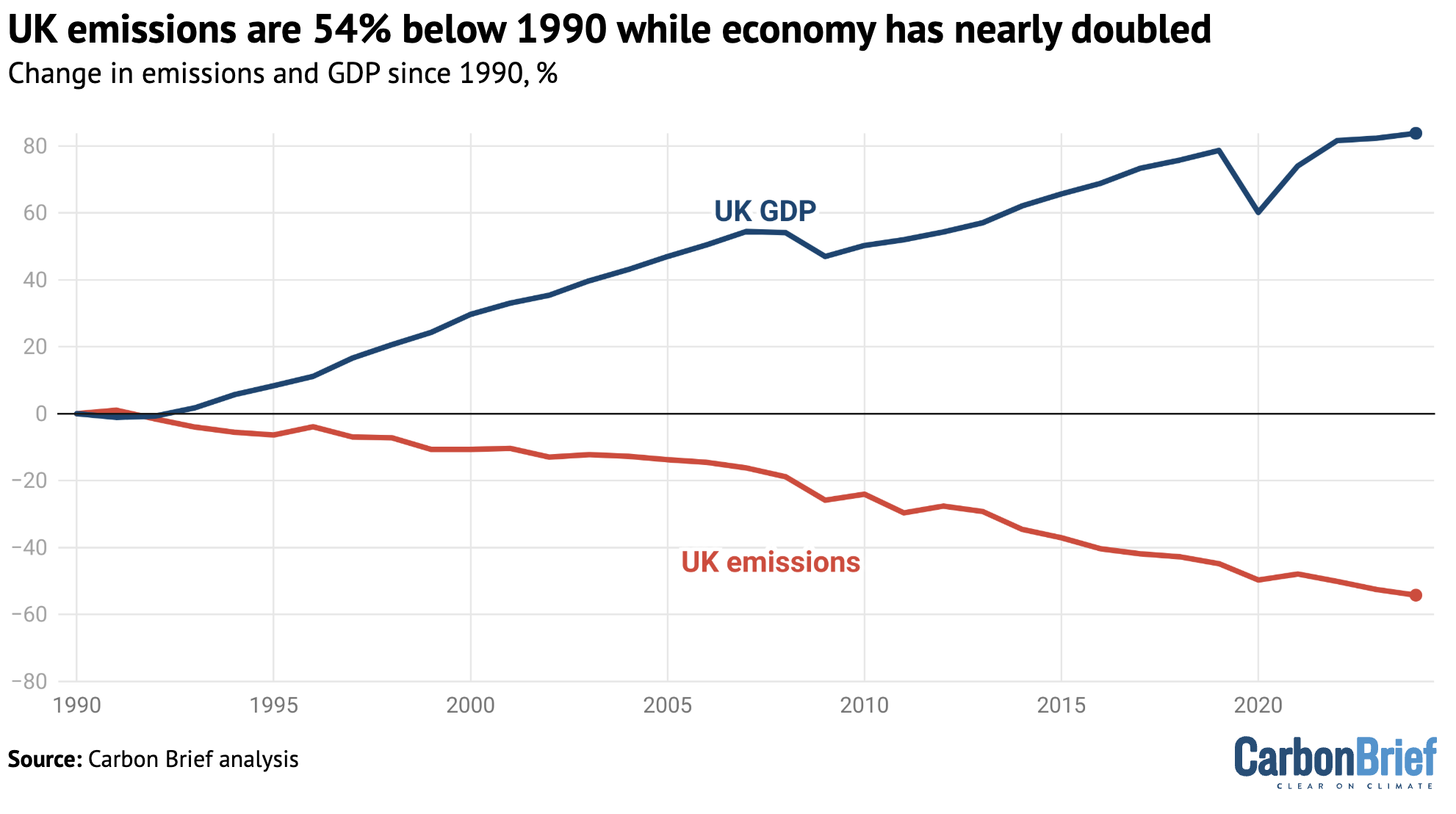
Taking an even longer view, the UK’s £2tn economy is now about 20 times larger than it was in 1872, after adjusting for inflation, whereas emissions are roughly the same.
Moreover, considering its population is now nearly 70 million people compared to 32m in 1872, the UK’s per-capita emissions have fallen two-fold, from 11.3tCO2e in 1872 to 5.4CO2e in 2024.
The 14MtCO2e drop in emissions in 2024 can be compared with the trajectory needed to reach the UK’s national and international climate pledges for 2035 and 2050.
If emissions fell by the same amount every year as they did in 2024, then the UK would miss both targets. It would need to cut emissions by 20MtCO2e each year to meet the 2035 target and by an average of 15MtCO2e per year to reach net-zero emissions by 2050.
In other words, annual emissions cuts would need to accelerate in the short- to medium-term, but could start to ease off later on. This is consistent with the cost-effective pathway to net-zero set out last month by the Climate Change Committee in its latest advice to the government.
Methodology
The starting point for Carbon Brief’s analysis of UK greenhouse gas emissions is preliminary government estimates of energy use by fuel. These are published quarterly, with the final quarter of each year appearing in figures published at the end of the following February. The same approach has accurately estimated year-to-year changes in emissions in previous years (see table, below).
| Year | Reported | Carbon Brief | Difference |
|---|---|---|---|
| 2010 | 2.4 | 2.6 | 0.2 |
| 2011 | -7.3 | -7.7 | -0.4 |
| 2012 | 2.9 | 3.6 | 0.7 |
| 2013 | -2.2 | -4.1 | -1.9 |
| 2014 | -7.5 | -7.5 | -0.0 |
| 2015 | -3.9 | -3.8 | 0.0 |
| 2016 | -5.2 | -5.7 | -0.4 |
| 2017 | -2.5 | -2.0 | 0.5 |
| 2018 | -1.5 | -1.8 | -0.3 |
| 2019 | -3.6 | -4.0 | -0.4 |
| 2020 | -8.8 | -8.9 | -0.0 |
| 2021 | 3.6 | 3.8 | 0.2 |
| 2022 | -4.2 | -3.5 | 0.7 |
| 2023 | -4.9 | -5.1 | -0.2 |
| 2024 | -3.6 |
Annual change in UK greenhouse gas emissions, %
One large source of uncertainty is the provisional energy use data, which is revised at the end of March each year and often again later on. Emissions data is also subject to revision in light of improvements in data collection and the methodology used, with major revisions in 2021.
The table above applies Carbon Brief’s emissions calculations to the comparable energy use and emissions figures, which may differ from those published previously.
Another source of uncertainty is the fact that Carbon Brief’s approach to estimating the annual change in emissions differs from the methodology used for the government’s own provisional estimates. The government has access to more granular data not available for public use.
Carbon Brief’s analysis takes figures on the amount of energy sourced from coal, oil and gas reported in Energy Trends 1.2. These figures are combined with conversion factors for the CO2 emissions per unit of energy, published annually by the UK government. Conversion factors are available for each fuel type, for example, petrol, diesel, gas and coal for electricity generation.
For oil, the analysis also draws on Energy Trends 3.13, which further breaks down demand according to the subtype of oil, for example, petrol, jet fuel and so on. Similarly, for coal, the analysis draws on Energy Trends 2.6, which breaks down solid fuel use by subtype.
Emissions from each fuel are then estimated from the energy use multiplied by the conversion factor, weighted by the relative proportions for each fuel subtype.
For example, the UK uses roughly 50m tonnes of oil equivalent (Mtoe) in the form of oil products, around half of which is from road diesel. So half the total energy use from oil is combined with the conversion factor for road diesel, another one-fifth for petrol and so on.
Energy use from each fossil fuel subtype is mapped onto the appropriate emissions conversion factor. In some cases, there is no direct read-across, in which case the nearest appropriate substitute is used. For example, energy use listed as “bitumen” is mapped to “processed fuel oils – residual oil”. Similarly, solid fuel used by “other conversion industries” is mapped to “petroleum coke”, and “other” solid fuel use is mapped to “coal (domestic)”.
The energy use figures are calculated on an inland consumption basis, meaning they include bunkers consumed in the UK for international transport by air and sea. In contrast, national emissions inventories exclude international aviation and shipping.
The analysis, therefore, estimates and removes the part of oil use that is due to the UK’s share of international aviation. It draws on the UK’s final greenhouse gas emissions inventory, which breaks emissions down by sector and reports the total for domestic aviation.
This domestic emissions figure is compared with the estimated emissions due to jet fuel use overall, based on the appropriate conversion factor. The analysis assumes that domestic aviation’s share of emissions is equivalent to its share of jet fuel energy use.
In addition to estimating CO2 emissions from fossil fuel use, Carbon Brief assumes that CO2 emissions from non-fuel sources, such as land-use change and forestry, are the same as a year earlier. The remaining greenhouse gas emissions are assumed to change in line with the latest government energy and emissions projections.
These assumptions are based on the UK government’s own methodology for preliminary greenhouse gas emissions estimates, published in 2019.
Note that the figures in this article are for emissions within the UK measured according to international guidelines. This means they exclude emissions associated with imported goods, including imported biomass, as well as the UK’s share of international aviation and shipping.
The Office for National Statistics (ONS) has published detailed comparisons between various different approaches to calculating UK emissions, on a territorial, consumption, environmental accounts or international accounting basis.
The UK’s consumption-based CO2 emissions increased between 1990 and 2007. Since then, however, they have fallen by a similar number of tonnes as emissions within the UK.
Bioenergy is a significant source of renewable energy in the UK and its climate benefits are disputed. Contrary to public perception, however, only around one-quarter of bioenergy is imported.
International aviation is considered part of the UK’s carbon budgets and faces the prospect of tighter limits on its CO2 emissions. The international shipping sector has a target to at least halve its emissions by 2050, relative to 2008 levels.
The post Analysis: UK emissions fall 3.6% in 2024 as coal use drops to lowest since 1666 appeared first on Carbon Brief.
Analysis: UK emissions fall 3.6% in 2024 as coal use drops to lowest since 1666
Greenhouse Gases
DeBriefed 15 August 2025: Raging wildfires; Xi’s priorities; Factchecking the Trump climate report
Welcome to Carbon Brief’s DeBriefed.
An essential guide to the week’s key developments relating to climate change.
This week
Blazing heat hits Europe
FANNING THE FLAMES: Wildfires “fanned by a heatwave and strong winds” caused havoc across southern Europe, Reuters reported. It added: “Fire has affected nearly 440,000 hectares (1,700 square miles) in the eurozone so far in 2025, double the average for the same period of the year since 2006.” Extreme heat is “breaking temperature records across Europe”, the Guardian said, with several countries reporting readings of around 40C.
HUMAN TOLL: At least three people have died in the wildfires erupting across Spain, Turkey and Albania, France24 said, adding that the fires have “displaced thousands in Greece and Albania”. Le Monde reported that a child in Italy “died of heatstroke”, while thousands were evacuated from Spain and firefighters “battled three large wildfires” in Portugal.
UK WILDFIRE RISK: The UK saw temperatures as high as 33.4C this week as England “entered its fourth heatwave”, BBC News said. The high heat is causing “nationally significant” water shortfalls, it added, “hitting farms, damaging wildlife and increasing wildfires”. The Daily Mirror noted that these conditions “could last until mid-autumn”. Scientists warn the UK faces possible “firewaves” due to climate change, BBC News also reported.
Around the world
- GRID PRESSURES: Iraq suffered a “near nationwide blackout” as elevated power demand – due to extreme temperatures of around 50C – triggered a transmission line failure, Bloomberg reported.
- ‘DIRE’ DOWN UNDER: The Australian government is keeping a climate risk assessment that contains “dire” implications for the continent “under wraps”, the Australian Financial Review said.
- EXTREME RAINFALL: Mexico City is “seeing one of its heaviest rainy seasons in years”, the Washington Post said. Downpours in the Japanese island of Kyushu “caused flooding and mudslides”, according to Politico. In Kashmir, flash floods killed 56 and left “scores missing”, the Associated Press said.
- SOUTH-SOUTH COOPERATION: China and Brazil agreed to “ensure the success” of COP30 in a recent phone call, Chinese state news agency Xinhua reported.
- PLASTIC ‘DEADLOCK’: Talks on a plastic pollution treaty have failed again at a summit in Geneva, according to the Guardian, with countries “deadlocked” on whether it should include “curbs on production and toxic chemicals”.
15
The number of times by which the most ethnically-diverse areas in England are more likely to experience extreme heat than its “least diverse” areas, according to new analysis by Carbon Brief.
Latest climate research
- As many as 13 minerals critical for low-carbon energy may face shortages under 2C pathways | Nature Climate Change
- A “scoping review” examined the impact of climate change on poor sexual and reproductive health and rights in sub-Saharan Africa | PLOS One
- A UK university cut the carbon footprint of its weekly canteen menu by 31% “without students noticing” | Nature Food
(For more, see Carbon Brief’s in-depth daily summaries of the top climate news stories on Monday, Tuesday, Wednesday, Thursday and Friday.)
Captured
Factchecking Trump’s climate report
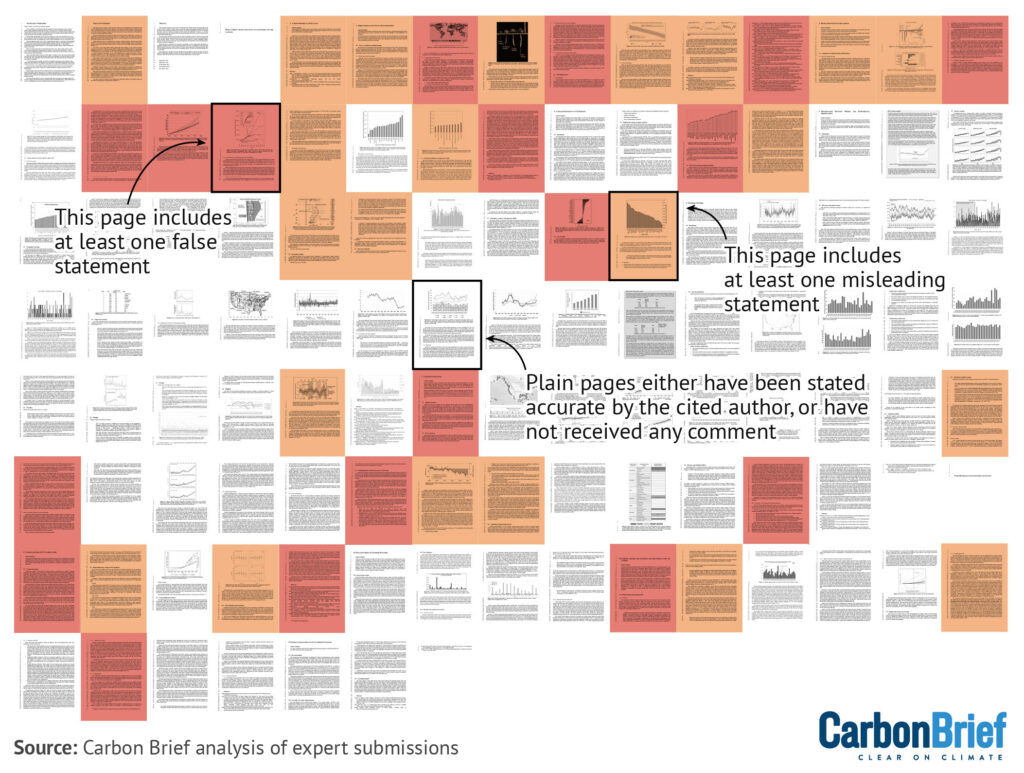
A report commissioned by the US government to justify rolling back climate regulations contains “at least 100 false or misleading statements”, according to a Carbon Brief factcheck involving dozens of leading climate scientists. The report, compiled in two months by five hand-picked researchers, inaccurately claims that “CO2-induced warming might be less damaging economically than commonly believed” and misleadingly states that “excessively aggressive [emissions] mitigation policies could prove more detrimental than beneficial”80
Spotlight
Does Xi Jinping care about climate change?
This week, Carbon Brief unpacks new research on Chinese president Xi Jinping’s policy priorities.
On this day in 2005, Xi Jinping, a local official in eastern China, made an unplanned speech when touring a small village – a rare occurrence in China’s highly-choreographed political culture.
In it, he observed that “lucid waters and lush mountains are mountains of silver and gold” – that is, the environment cannot be sacrificed for the sake of growth.
(The full text of the speech is not available, although Xi discussed the concept in a brief newspaper column – see below – a few days later.)
In a time where most government officials were laser-focused on delivering economic growth, this message was highly unusual.
Forward-thinking on environment
As a local official in the early 2000s, Xi endorsed the concept of “green GDP”, which integrates the value of natural resources and the environment into GDP calculations.
He also penned a regular newspaper column, 22 of which discussed environmental protection – although “climate change” was never mentioned.
This focus carried over to China’s national agenda when Xi became president.
New research from the Asia Society Policy Institute tracked policies in which Xi is reported by state media to have “personally” taken action.
It found that environmental protection is one of six topics in which he is often said to have directly steered policymaking.
Such policies include guidelines to build a “Beautiful China”, the creation of an environmental protection inspection team and the “three-north shelterbelt” afforestation programme.
“It’s important to know what Xi’s priorities are because the top leader wields outsized influence in the Chinese political system,” Neil Thomas, Asia Society Policy Institute fellow and report co-author, told Carbon Brief.
Local policymakers are “more likely” to invest resources in addressing policies they know have Xi’s attention, to increase their chances for promotion, he added.
What about climate and energy?
However, the research noted, climate and energy policies have not been publicised as bearing Xi’s personal touch.
“I think Xi prioritises environmental protection more than climate change because reducing pollution is an issue of social stability,” Thomas said, noting that “smoggy skies and polluted rivers” were more visible and more likely to trigger civil society pushback than gradual temperature increases.
The paper also said topics might not be linked to Xi personally when they are “too technical” or “politically sensitive”.
For example, Xi’s landmark decision for China to achieve carbon neutrality by 2060 is widely reported as having only been made after climate modelling – facilitated by former climate envoy Xie Zhenhua – showed that this goal was achievable.
Prior to this, Xi had never spoken publicly about carbon neutrality.
Prof Alex Wang, a University of California, Los Angeles professor of law not involved in the research, noted that emphasising Xi’s personal attention may signal “top” political priorities, but not necessarily Xi’s “personal interests”.
By not emphasising climate, he said, Xi may be trying to avoid “pushing the system to overprioritise climate to the exclusion of the other priorities”.
There are other ways to know where climate ranks on the policy agenda, Thomas noted:
“Climate watchers should look at what Xi says, what Xi does and what policies Xi authorises in the name of the ‘central committee’. Is Xi talking more about climate? Is Xi establishing institutions and convening meetings that focus on climate? Is climate becoming a more prominent theme in top-level documents?”
Watch, read, listen
TRUMP EFFECT: The Columbia Energy Exchange podcast examined how pressure from US tariffs could affect India’s clean energy transition.
NAMIBIAN ‘DESTRUCTION’: The National Observer investigated the failure to address “human rights abuses and environmental destruction” claims against a Canadian oil company in Namibia.
‘RED AI’: The Network for the Digital Economy and the Environment studied the state of current research on “Red AI”, or the “negative environmental implications of AI”.
Coming up
- 17 August: Bolivian general elections
- 18-29 August: Preparatory talks on the entry into force of the “High Seas Treaty”, New York
- 18-22 August: Y20 Summit, Johannesburg
- 21 August: Advancing the “Africa clean air programme” through Africa-Asia collaboration, Yokohama
Pick of the jobs
- Lancaster Environment Centre, senior research associate: JUST Centre | Salary: £39,355-£45,413. Location: Lancaster, UK
- Environmental Justice Foundation, communications and media officer, Francophone Africa | Salary: XOF600,000-XOF800,000. Location: Dakar, Senegal
- Politico, energy & climate editor | Salary: Unknown. Location: Brussels, Belgium
- EnviroCatalysts, meteorologist | Salary: Unknown. Location: New Delhi, India
DeBriefed is edited by Daisy Dunne. Please send any tips or feedback to debriefed@carbonbrief.org.
This is an online version of Carbon Brief’s weekly DeBriefed email newsletter. Subscribe for free here.
The post DeBriefed 15 August 2025: Raging wildfires; Xi’s priorities; Factchecking the Trump climate report appeared first on Carbon Brief.
DeBriefed 15 August 2025: Raging wildfires; Xi’s priorities; Factchecking the Trump climate report
Greenhouse Gases
Cropped 13 August 2025: Fossil-fuelled bird decline; ‘Deadly’ wildfires; Empty nature fund
We handpick and explain the most important stories at the intersection of climate, land, food and nature over the past fortnight.
This is an online version of Carbon Brief’s fortnightly Cropped email newsletter. Subscribe for free here.
Key developments
‘Deadly’ wildfires
WINE BRAKE: France experienced its “largest wildfire in decades”, which scorched more than 16,000 hectares in the country’s southern Aude region, the Associated Press said. “Gusting winds” fanned the flames, Reuters reported, but local winemakers and mayors also “blam[ed] the loss of vineyards”, which can act as a “natural, moisture-filled brake against wildfires”, for the fire’s rapid spread. It added that thousands of hectares of vineyards were removed in Aude over the past year. Meanwhile, thousands of people were evacuated from “deadly” wildfires in Spain, the Guardian said, with blazes ongoing in other parts of Europe.
MAJOR FIRES: Canada is experiencing its second-worst wildfire season on record, CBC News reported. More than 7.3m hectares burned in 2025, “more than double the 10-year average for this time of year”, the broadcaster said. The past three fire seasons were “among the 10 worst on record”, CBC News added. Dr Mike Flannigan from Thompson Rivers University told the Guardian: “This is our new reality…The warmer it gets, the more fires we see.” Elsewhere, the UK is experiencing a record year for wildfires, with more than 40,000 hectares of land burned so far in 2025, according to Carbon Brief.
-
Sign up to Carbon Brief’s free “Cropped” email newsletter. A fortnightly digest of food, land and nature news and views. Sent to your inbox every other Wednesday.
WESTERN US: The US state of Colorado has recorded one of its largest wildfires in history in recent days, the Guardian said. The fire “charred” more than 43,300 hectares of land and led to the temporary evacuation of 179 inmates from a prison, the newspaper said. In California, a fire broke out “during a heatwave” and burned more than 2,000 hectares before it was contained, the Los Angeles Times reported. BBC News noted: “Wildfires have become more frequent in California, with experts citing climate change as a key factor. Hotter, drier conditions have made fire seasons longer and more destructive.”
FIRE FUNDING: “Worsening fires” in the Brazilian Amazon threaten new rainforest funding proposals due to be announced at the COP30 climate summit later this year, experts told Climate Home News. The new initiatives include the Tropical Forests Forever Facility, which the outlet said “aims to generate a flow of international investment to pay countries annually in proportion to their preserved tropical forests”. The outlet added: “If fires in the Amazon continue to worsen in the years to come, eligibility for funding could be jeopardised, Brazil’s environment ministry acknowledged.”
Farming impacts
OUT OF ORBIT: US president Donald Trump moved to “shut down” two space missions which monitor carbon dioxide and plant health, the Associated Press reported. Ending these NASA missions would “potentially shu[t] off an important source of data for scientists, policymakers and farmers”, the outlet said. Dr David Crisp, a retired NASA scientist, said the missions can detect the “glow” of plant growth, which the outlet noted “helps monitor drought and predict food shortages that can lead to civil unrest and famine”.
FARM EXTREMES: Elsewhere, Reuters said that some farmers are considering “abandoning” a “drought-hit” agricultural area in Hungary as “climate change cuts crop yields and reduces groundwater levels”. Scientists warned that rising temperatures and low rainfall threaten the region’s “agricultural viability”, the newswire added. Meanwhile, the Premium Times in Nigeria said that some farmers are “harvest[ing] crops prematurely” due to flooding fears. A community in the south-eastern state of Imo “has endured recurrent floods, which wash away crops and incomes alike” over the past decade, the newspaper noted.
SECURITY RISKS: Food supply chains in the UK face “escalating threats from climate impacts and the migration they are triggering”, according to a report covered by Business Green. The outlet said that £3bn worth of UK food imports originated from the 20 countries “with the highest numbers of climate-driven displacements” in 2024, based on analysis from the Energy and Climate Intelligence Unit. The analysis highlighted that “climate impacts on food imports pose a threat to UK food security”. Elsewhere, an opinion piece in Dialogue Earth explored how the “role of gender equity in food security remains critically unaddressed”.
Spotlight
Fossil-fuelled bird decline
This week, Carbon Brief covers a new study tracing the impact of fossil-fuelled climate change on tropical birds.
Over the past few years, biologists have recorded sharp declines in bird numbers across tropical rainforests – even in areas untouched by humans – with the cause remaining a mystery.
A new study published this week in Nature Ecology and Evolution could help to shed light on this alarming phenomenon.
The research combined ecological and climate attribution techniques for the first time to trace the fingerprint of fossil-fuelled climate change on declining bird populations.
It found that an increase in heat extremes driven by climate change has caused tropical bird populations to decline by 25-38% in the period 1950-2020, when compared to a world without warming.
In their paper, the authors noted that birds in the tropics could be living close to their “thermal limits”.
Study lead author Dr Maximilian Kotz, a climate scientist at the Barcelona Supercomputing Center in Spain, explained to Carbon Brief:
“High temperature extremes can induce direct mortality in bird populations due to hyperthermia and dehydration. Even when they don’t [kill birds immediately], there’s evidence that this can then affect body condition which, in turn, affects breeding behaviour and success.”
Conservation implications
The findings have “potential ramifications” for commonly proposed conservation strategies, such as increasing the amount of land in the tropics that is protected for nature, the authors said. In their paper, they continued:
“While we do not disagree that these strategies are necessary for abating tropical habitat loss…our research shows there is now an additional urgent need to investigate strategies that can allow for the persistence of tropical species that are vulnerable to heat extremes.”
In some parts of the world, scientists and conservationists are looking into how to protect wildlife from more intense and frequent climate extremes, Kotz said.
He referenced one project in Australia which is working to protect threatened wildlife following periods of extreme heat, drought and bushfires.
Prof Alex Pigot, a biodiversity scientist at University College London (UCL), who was not involved in the research, said the findings reinforced the need to systematically monitor the impact of extreme weather on wildlife. He told Carbon Brief:
“We urgently need to develop early warning systems to be able to anticipate in advance where and when extreme heatwaves and droughts are likely to impact populations – and also rapidly scale up our monitoring of species and ecosystems so that we can reliably detect these effects.”
There is further coverage of this research on Carbon Brief’s website.
News and views
EMPTY CALI FUND: A major voluntary fund for biodiversity remains empty more than five months after its launch, Carbon Brief revealed. The Cali Fund, agreed at the COP16 biodiversity negotiations last year, was set up for companies who rely on nature’s resources to share some of their earnings with the countries where many of these resources originate. Big pharmaceutical companies did not take up on opportunities to commit to contributing to the fund or be involved in its launch in February 2025, emails released to Carbon Brief showed. Just one US biotechnology firm has pledged to contribute to the fund in the future.
LOSING HOPE: Western Australia’s Ningaloo reef – long considered a “hope spot” among the country’s coral reefs for evading major bleaching events – is facing its “worst-ever coral bleaching”, Australia’s ABC News reported. The ocean around Ningaloo has been “abnormally” warm since December, resulting in “unprecedented” bleaching and mortality, a research scientist told the outlet. According to marine ecologist Dr Damian Thomson, “up to 50% of the examined coral was dead in May”, the Sydney Morning Herald said. Thomson told the newspaper: “You realise your children are probably never going to see Ningaloo the way you saw it.”
‘DEVASTATION BILL’: Brazil’s president, Luiz Inácio Lula da Silva, signed a “contentious” environmental bill into law, but “partially vetoed” some of the widely criticised elements, the Financial Times reported. Critics, who dubbed it the “devastation bill”, said it “risked fuelling deforestation and would harm Brazil’s ecological credentials” just months before hosting the COP30 climate summit. The newspaper said: “The leftist leader struck down or altered 63 of 400 provisions in the legislation, which was designed to speed up and modernise environmental licensing for new business and infrastructure developments.” The vetoes need to be approved by congress, “where Lula lacks a majority”, the newspaper noted.
RAINFOREST DRILLING: The EU has advised the Democratic Republic of the Congo (DRC) against allowing oil drilling in a vast stretch of rainforest and peatland that was jointly designated a “green corridor” earlier this year, Climate Home News reported. In May, the DRC announced that it planned to open the conservation area for drilling, the publication said. A spokesperson for the European Commission told Climate Home News that the bloc “fully acknowledges and respects the DRC’s sovereign right to utilise its diverse resources for economic development”, but that it “highlights the fact that green alternatives have facilitated the protection of certain areas”.
NEW PLAN FOR WETLANDS: During the 15th meeting of the Ramsar Convention on Wetlands, held in Zimbabwe from 23 to 31 July, countries agreed on the adoption of a new 10-year strategic plan for conserving and sustainably using the world’s wetlands. Down to Earth reported that 13 resolutions were adopted, including “enhancing monitoring and reporting, capacity building and mobilisation of resources”. During the talks, Zimbabwe’s environment minister announced plans to restore 250,000 hectares of degraded wetlands by 2030 and Saudi Arabia entered the Convention on Wetlands. Panamá will host the next COP on wetlands in July 2028.
MEAT MADNESS: DeSmog covered the details of a 2021 public relations document that revealed how the meat industry is trying to “make beef seem climate-friendly”. The industry “may have enlisted environmental groups to persuade people to ‘feel better’ about eating beef”, the outlet said, based on this document. The strategy was created by a communications agency, MHP Group, and addressed to the Global Roundtable for Sustainable Beef. One of the key messages of the plan was to communicate the “growing momentum in the beef industry to protect and nurture the Earth’s natural resources”. MHP Group did not respond to a request for comment, according to DeSmog.
Watch, read, listen
MAKING WAVES: A livestream of deep-sea “crustaceans, sponges and sea cucumbers” has “captivated” people in Argentina, the New York Times outlined.
BAFFLING BIRDS: The Times explored the backstory to the tens of thousands of “exotic-looking” parakeets found in parks across Britain.
PLANT-BASED POWER: In the Conversation, Prof Paul Behrens outlined how switching to a plant-based diet could help the UK meet its climate and health targets.
MARINE DISCRIMINATION: Nature spoke to a US-based graduate student who co-founded Minorities in Shark Science about her experiences of racism and sexism in the research field.
New science
- Applying biochar – a type of charcoal – to soils each year over a long period of time can have “sustained benefits for crop yield and greenhouse gas mitigation”, according to a Proceedings of the National Academy of Sciences study.
- New research, published in PLOS Climate, found that nearly one-third of highly migratory fish species in the US waters of the Atlantic Ocean have “high” or “very high” vulnerability to climate change, but the majority of species have “some level of resilience and adaptability”.
- A study in Communications Earth & Environment found a “notable greening trend” in China’s wetlands over 2000-23, with an increasing amount of carbon being stored in the plants growing there.
In the diary
- 18-29 August: Second meeting of the preparatory commission for the Agreement on Marine Biological Diversity of Areas beyond National Jurisdiction | New York
- 24-28 August: World Water Week | Online and Stockholm, Sweden
- 26-29 August: Sixth forum of ministers and environment authorities of Asia Pacific | Nadi, Fiji
Cropped is researched and written by Dr Giuliana Viglione, Aruna Chandrasekhar, Daisy Dunne, Orla Dwyer and Yanine Quiroz. Please send tips and feedback to cropped@carbonbrief.org
The post Cropped 13 August 2025: Fossil-fuelled bird decline; ‘Deadly’ wildfires; Empty nature fund appeared first on Carbon Brief.
Cropped 13 August 2025: Fossil-fuelled bird decline; ‘Deadly’ wildfires; Empty nature fund
Greenhouse Gases
Holding the line on climate: EPA
CCL submits a formal comment on EPA’s proposed endangerment finding rollback
By Dana Nuccitelli, CCL Research Manager
On July 29, the EPA proposed to rescind its 2009 endangerment finding that forms the basis of all federal climate pollution regulations.
Without the endangerment finding, the EPA may not be allowed or able to regulate greenhouse gas pollution from sources like power plants or vehicle tailpipes, as they have done for years. News coverage has framed this as a “radical transformation” and a “bid to scrap almost all pollution regulations,” so it has appropriately alarmed many folks in the climate and environment space.
At CCL, we focus our efforts on working with Congress to implement durable climate policies, and so we don’t normally take actions on issues like this that relate to federal agencies or the courts. Other organizations focus their efforts on those branches of the government and are better equipped to spearhead this type of moment, and we appreciate those allies.
But in this case, we did see an opportunity for CCL’s voice — and our focus on Congress — to play a role here. We decided to submit a formal comment on this EPA action for two reasons.
First, this decision could have an immense impact by eliminating every federal regulation of climate pollutants in a worst case scenario. Second, this move relates to our work because the EPA is misinterpreting the text and intent of laws passed by Congress. Our representatives have done their jobs by passing legislation over the past many decades that supports and further codifies the EPA’s mandate to regulate climate pollution. That includes the Clean Air Act, and more recently, the Inflation Reduction Act. We at CCL wanted to support our members of Congress by making these points in a formal comment.
There has been a tremendous public response to this action. In just over one week, the EPA already received over 44,000 public comments on its decision, and the public comment period will remain open for another five weeks, until September 15.
To understand more about the details and potential outcomes of the EPA’s actions, read my article on the subject at Yale Climate Connections, our discussion on CCL Community, and CCL’s formal comment, which represents our entire organization. As our comment concludes,
“In its justifications for rescinding the 2009 endangerment finding, the Reconsideration has misinterpreted the text of the Clean Air Act, Congress’ decadeslong support for the EPA’s mandate to regulate greenhouse gas emissions from motor vehicles and other major sources, and the vast body of peer-reviewed climate science research that documents the increasingly dangerous threats that those emissions pose to Americans’ health and welfare. Because the bases of these justifications are fundamentally flawed, CCL urges the EPA to withdraw its ill-conceived Reconsideration of the 2009 endangerment finding. The EPA has both the authority and the responsibility to act. Americans cannot afford a retreat from science, law, and common sense in the face of a rapidly accelerating climate crisis.”
After the EPA responds to the public comment record and finalizes its decision, this issue will ultimately be decided by the Supreme Court several years from now.
In the meantime, CCL will continue to focus our efforts on areas where we can make the biggest difference in preserving a livable climate. Right now, that involves contacting our members of Congress to urge them to fully fund key climate and energy programs and protect critical work at the National Oceanic and Atmospheric Administration (NOAA), National Aeronautics and Space Administration (NASA), and Department of Energy. We’ve set an ambitious goal of sending 10,000 messages to our members of Congress, so let’s all do what CCL does best and make our voices heard on this critical issue.
This action by the EPA also reminds us that federal regulations are fragile. They tend to change with each new administration coming into the White House. Legislation passed by Congress – especially when done on a bipartisan basis – is much more durable. That’s why CCL’s work, as one of very few organizations engaging in nonpartisan advocacy for long-lasting climate legislation, is so critical.
That’s especially true right now when we’re seeing the Trump administration slam shut every executive branch door to addressing climate change. We need Congress to step up now more than ever to implement durable solutions like funding key climate and energy programs, negotiating a new bipartisan comprehensive permitting reform bill, implementing healthy forest solutions like the Fix Our Forests Act, and advancing conversations about policies to put a price on carbon pollution. Those are the kinds of effective, durable, bipartisan climate solutions that CCL is uniquely poised to help become law and make a real difference in preserving a livable climate.
For other examples of how CCL is using our grassroots power to help ensure that Congress stays effective on climate in this political landscape, see our full “Holding the Line on Climate” blog series.
The post Holding the line on climate: EPA appeared first on Citizens' Climate Lobby.
-
Climate Change2 years ago
Spanish-language misinformation on renewable energy spreads online, report shows
-
Climate Change Videos2 years ago
The toxic gas flares fuelling Nigeria’s climate change – BBC News
-

 Greenhouse Gases1 year ago
Greenhouse Gases1 year ago嘉宾来稿:满足中国增长的用电需求 光伏加储能“比新建煤电更实惠”
-

 Climate Change1 year ago
Climate Change1 year ago嘉宾来稿:满足中国增长的用电需求 光伏加储能“比新建煤电更实惠”
-

 Carbon Footprint1 year ago
Carbon Footprint1 year agoUS SEC’s Climate Disclosure Rules Spur Renewed Interest in Carbon Credits
-
Climate Change2 years ago
Why airlines are perfect targets for anti-greenwashing legal action
-
Climate Change Videos2 years ago
The toxic gas flares fuelling Nigeria’s climate change – BBC News
-
Climate Change2 years ago
Some firms unaware of England’s new single-use plastic ban



